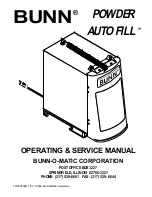
5
DANGER
CO2 (CARBON DIOXIDE)
CO2 cylinders must always be stored in a well-ventilated place where the air can flow in and out. Great
care must be taken to prevent CO2 leaks throughout the system, including the gas cylinders.
If a CO2 leak is suspected, especially in a small area, ventilate the contaminated area at once, persons
exposed to high concentrations of CO2 will experience trembling, swiftly followed by unconsciousness
and suffocation.
DANGER
ELECTRICAL MAINS
Always disconnect the equipment from the electricity supply before carrying out any work, to prevent
DANGER
GAS CYLINDER LOCATION
To prevent the risk of injury or damage, the CO2 cylinder must always be kept in a vertical position
against a wall, held in place by a chain fixed to a bracket. Do not expose the bottle to heat sources or
very low temperatures.
Only super-dry food grade CO2 should be used.
Before connecting the pressure reducer to the gas cylinder, always vent any dirt from the valve, and
close the cylinder valve after few seconds
DANGER
Keep the ventilation openings on the equipment and on the cabinet in which the system is installed
free from obstruction.
DANGER
AUTHORIZED TECHNICAL STAFF
The refrigerant R290 (Propane) is flammable and it must be handled only by competent and responsible
operators, under the conditions specified in the safety regulations in force.
CAUTION
ELECTRICAL REQUIREMENTS
The electrical circuit must be correctly earthed and connected by means of a suitable differential safety
breaker.
CAUTION
REPLACEMENT OF THE POWER CABLE
If the power cable is damaged, it must be replaced by the manufacturer or their assistance service or a
similarly qualified person in order to prevent any possible risk.
CAUTION
LOW TEMPERATURE
If the equipment is exposed to temperatures lower than O°C, the water inside could turn to ice and
damage the equipment.
CAUTION
SANITISATION
Before sanitising the equipment, carefully read the instructions given by the sanitisation product
manufacturer and put on all the necessary personal protective equipment (gloves, masks, etc.).
Ensure that the premises are well ventilated.
The sanitisation operations should only be carried out by specialised technical assistance personnel.
2.4 LIST OF HAZARDS
The following list of hazards draws attention to safety aspects which must be considered at all times by anyone using the equipment
.
Safe operating temperature:
N from +16 ° C to +32 ° C (standard class)
Cooling system:
Aluminium black heat exchanger.
Colling capacity:
35-40 litres/hour.
Electrical requirements:
Two 13 amp sockets operating on 230V single phase.
Voltage and frequency ratings:
230V / 50Hz.
Max power consumption (chiller):
200W.
Compressor nominal power:
1/8 HP.
Refrigerant type and quantity:
R290 / 45 gr.
Carbonator volume (just for SW versions):
1ltr.
Net Weight:
35kg.
Mains water pressure required
downstream of any filter systems:
22 - 140psi (150 - 1000kPa) (1.5 - 10 bar)
If mains pressure is below 1 bar or the
flow rate is less than 2L/min:
fit a device capable of increasing the mains pressure (autoclave or similar). ensure
your water net is able to supply at least 2L/min water flowrate.
Water connection:
3/8” Quick connection fitting.
Electrical requirements:
Two 13 amp sockets operating on 230V single phase.
Machine location:
The machine must be located in a well ventilated space, at least 10cm (3.9inch)
around back and top for ventilation.
1.1 Installation Requirements
(See also Basic Installation p7, Installation Guide p13)
WARNING
Shows the existence, on or around the equipment, of a potential risk of death or severe injury for the
operator or other persons; it is therefore essential to take great care and proceed with the greatest
caution.
CAUTION
Shows the existence, on or around the equipment, of a potential risk of minor injury for the operator
or other persons; it is therefore essential to take great care and proceed with the greatest caution.






































